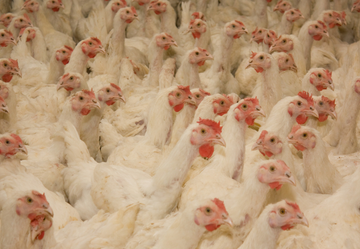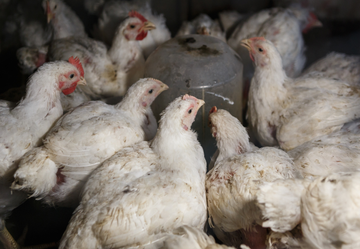Why the Better Chicken Commitment
Consumers are demanding improved animal welfare and food quality standards.

Consumer Demand
Studies show that consumers are increasingly concerned about where their food comes from.

Consumer preferences for higher welfare meat also translates to their purchasing decisions—from restaurants to supermarkets. Mintel reported that while total sales of poultry were down in 2016, the brands performing well were those with ethical claims.[1] Mintel also found that customers are willing to pay at least a dollar more for a “more ethical poultry product,” as compared to conventionally raised chicken. In addition, in a 2017 survey, over 80 percent of Canadian respondents favoured a wide variety of animal welfare improvements for broiler chickens, from improved lighting standards (89 percent favoured) to enriched living conditions (84 percent favoured).[2]
Quality Problems
“While overall meat consumption per capita in Canada has declined, poultry consumption has consistently been on the rise. Between 2010 and 2017, poultry consumption grew by 6.3 percent.[3] And supply follows demand; between 2011 and 2016, the number of broiler farms in Canada increased by 11 percent.”[4] It is the strong consumer demand for white meat that drove the broiler industry to breed a chicken that would grow as quickly, and as large as possible to deliver as much white meat as possible.
This accelerated growth for high yield has resulted in product quality issues affecting the chicken market—namely the widespread issues of muscular myopathies such as woody breast and white striping. Woody breast causes the meat to be tough and difficult to chew, while white striping is a visible condition in which fat and collagen congeal in white stripes across the outside of chicken breasts. These abnormalities are strongly linked to accelerated weight gain and rapid breast muscle growth in the most popular broiler breeds.
The introduction of higher-welfare breeds could significantly reduce meat quality abnormalities.
Animal Welfare
The vast majority of chickens in Canada are raised in conditions where the following factors contribute to serious health and welfare issues:
Breed
The modern chicken has been selectively bred and commercialized over many decades, prioritizing fast growth and large breast muscles over any consideration for welfare. Chickens now grow so big, so quickly, their bodies can’t keep up. Their legs can’t cope with the weight of their upper bodies[5], so they suffer from leg pain and lameness. Their hearts and other organs are under pressure, and many die prematurely from heart disease.

Stocking Density
Numerous studies have linked the problems of movement and ammonia burns to stocking density.[6] When chickens are crammed so tightly together, the litter becomes soiled more quickly, and mobility is decreased because birds have inadequate room to move.

Housing
As standard industry practice, chickens are forced to live in a completely barren environment with wet, dirty litter. They are subjected to near-constant, low-intensity artificial lighting with short periods of continuous darkness and virtually no stimulating resources. Farms rarely change the litter between flocks of chickens, which means birds must sit in their own waste for their entire lives. This constant contact with the ammonia-laden litter causes foot pad dermatitis (lesions on the bottom of their feet), breast blisters, and hock burns (ammonia burns through the skin). These conditions all result in extremely poor welfare.

Slaughter
The most prevalent slaughter method in the United States poultry industry is live-shackling, a system by which birds are hung upside down by their feet in metal shackles.[7] An electrified water bath is meant to give them a shock that renders them unconscious; however, many are not effectively stunned and continue in the process while conscious. Some may then still be conscious at the point of having their throats cut, and a small but not insignificant percentage are alive long enough to experience the boiling water that is used to remove their feathers.
Mintel. (2016). Poultry – US – November 2016. Retrieved from https://reports.mintel.com/display/860881 ↩︎
NRG Research Group. (2017). Broiler Chicken Welfare Survey: Canadian General Public Survey. https://mercyforanimals.org/files/MFA_2017_Survey_CA.pdf ↩︎
Food and Agriculture Organization of the United Nations. New food balances. FAOSTAT database. Retrieved March 17, 2020, from http://www.fao.org/faostat/en/#data/FBS ↩︎
Agriculture and Agri-Food Canada. (2018). Number of farms by industry type. Government of Canada. http://www.agr.gc.ca/eng/animal-industry/poultry-and-eggs/poultry-and-egg-market-information/industry-indicators/number-of-farms-by-industry-type/?id=1384971854416 ↩︎
Lilburn, M. S. Skeletal growth of commercial poultry species. Poult. Sci. 73, 897–903 (1994). ↩︎
Haslam, S. M. et al. Factors affecting the prevalence of foot pad dermatitis, hock burn and breast burn in broiler chicken. Br. Poult. Sci. 48, 264–275 (2007) ↩︎
Shields, S. J. & Raj, A. B. M. A critical review of electrical water-bath stun systems for poultry slaughter and recent developments in alternative technologies. J. Appl. Anim. Welf. Sci. 13, 281–299 (2010). ↩︎
